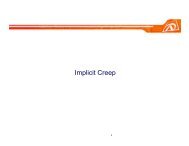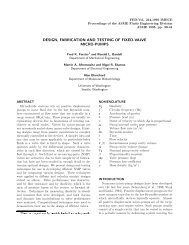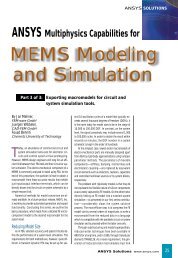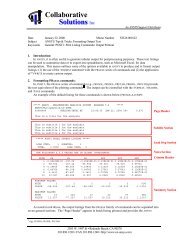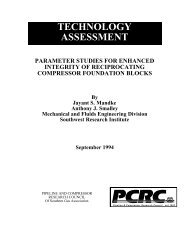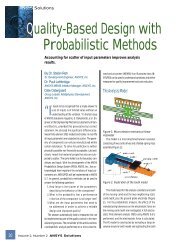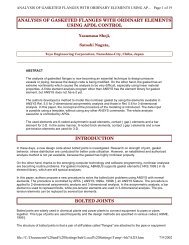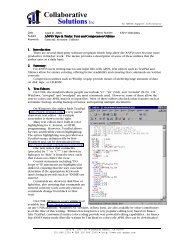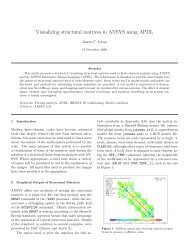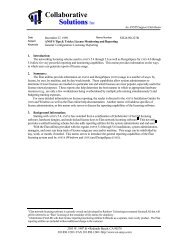anisotropic plasticity and failure prediction in wood ... - ANSYS Users
anisotropic plasticity and failure prediction in wood ... - ANSYS Users
anisotropic plasticity and failure prediction in wood ... - ANSYS Users
Create successful ePaper yourself
Turn your PDF publications into a flip-book with our unique Google optimized e-Paper software.
ANISOTROPIC PLASTICITY AND FAILURE PREDICTION IN WOOD COMPOSI...<br />
Us<strong>in</strong>g the <strong>anisotropic</strong> <strong>plasticity</strong> material model, the stress concentration factor was at least 2.0 (roughly) as<br />
<strong>in</strong>dicated <strong>in</strong> Table 5. The difference <strong>in</strong> values between the three planes may, <strong>in</strong> part, be attributed to assumed<br />
values of the shear moduli, given <strong>in</strong> Table 2. Cramer et al. (1984) <strong>in</strong>dicated that <strong>in</strong>clud<strong>in</strong>g the effects of crush<strong>in</strong>g<br />
through a non-l<strong>in</strong>ear compression stress model would result <strong>in</strong> stress concentration factors lower than their<br />
calculated value of 2.36 due to the release of stra<strong>in</strong> energy through ductile behavior. This is not always the case<br />
as shown <strong>in</strong> Table 5.<br />
Table 5. Stress concentration factors for shear blocks at ultimate load<br />
Specimen Peak stress (see Figure 8)<br />
Note: values are average peaks between sections A-B <strong>and</strong> A'-B'.<br />
It was previously mentioned that a two-dimensional model would be sufficient to determ<strong>in</strong>e the stress distribution.<br />
The current three-dimensional model can be used, however, to determ<strong>in</strong>e if brittle <strong>failure</strong> occurred <strong>in</strong> tension <strong>in</strong><br />
the X, Y or Z directions. Us<strong>in</strong>g the reference stress values determ<strong>in</strong>ed from the tension tests (shown <strong>in</strong> Table 1) at<br />
p = 0.5, it was found that delam<strong>in</strong>ation <strong>failure</strong> (tension <strong>in</strong> the Z-direction) occurred at roughly 40% of the ultimate<br />
displacement as shown <strong>in</strong> Table 6. The specimen could still carry load, as was observed <strong>in</strong> experiments, but the<br />
analysis <strong>in</strong>dicated that the tensile stress concentration <strong>in</strong> the region of the notch would produce delam<strong>in</strong>ation.<br />
Table 6. Predicted ultimate load due to shear or tension <strong>failure</strong><br />
Stress concentration factor<br />
XY - large 3531 2.2<br />
XY - small 2867 1.8<br />
YZ - large 1884 3.3<br />
YZ - small 2446 2.7<br />
XZ - large 1297 3.2<br />
XZ - small 1392 4.0<br />
Specimen Max. Load (lbs.) Max. load due to<br />
tension <strong>failure</strong> <strong>in</strong> X<br />
or Z (lbs.)<br />
Tension load/shear<br />
load<br />
XY - large 4808 1850 (Z) 0.38<br />
XY - small 2237 1200 (Z) 0.54<br />
YZ - large 2292 830 (Z) 0.36<br />
YZ - small 1820 830 (Z) 0.46<br />
XZ - large 1642 460 (X & Z) 0.28<br />
XZ - small 688 260 (X & Z) 0.38<br />
Tension <strong>failure</strong> due to delam<strong>in</strong>ation <strong>in</strong> Z-direction <strong>in</strong>dicated by (Z) <strong>and</strong> tension <strong>failure</strong> perpendicularto-gra<strong>in</strong><br />
<strong>in</strong>dicated by (X)<br />
CASE STUDY II - SINGLE-BOLT CONNECTION<br />
Page 16 of 22<br />
The performance of connections <strong>in</strong> timber is dependent on many factors <strong>in</strong>clud<strong>in</strong>g: bolt size, end distance, edge<br />
distance, member thickness, species, hole diameter, direction of load<strong>in</strong>g, <strong>and</strong> bolt yield stress. Only some of<br />
these parameters have been <strong>in</strong>cluded <strong>in</strong> early models of connections <strong>in</strong> <strong>wood</strong>. A one-dimensional f<strong>in</strong>ite element<br />
model of nails <strong>and</strong>/or rivets <strong>in</strong> timber was developed us<strong>in</strong>g cubic polynomial displacement functions <strong>and</strong> beam<br />
file://C:\Documents%20<strong>and</strong>%20Sett<strong>in</strong>gs\beh\Local%20Sett<strong>in</strong>gs\Temp\~hhC936.htm<br />
7/9/2002



